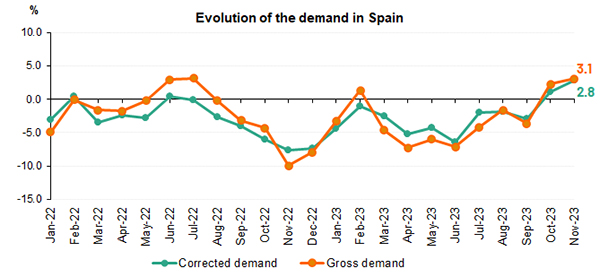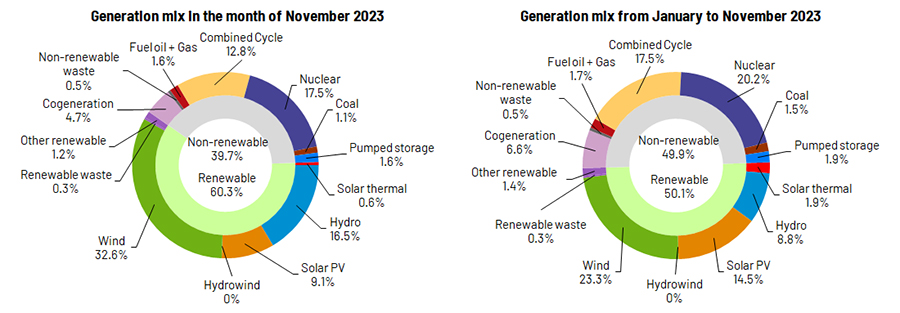For 40 years, we've been driving our country's economic and social progress. Four decades shaping Spain.
Demand for electricity in Spain increased 2.8% in November
- 60.3% of electricity production during the month came from renewable sources, the highest share in the national mix since records began.
- 3 November was the day with the highest daily share of renewable generation, accounting for 73.3% of the total.

National electricity demand in November experienced a 2.8% increase year-on-year after having factored in the influence of seasonal and working patterns. In gross terms, demand is estimated at 19,891 GWh, up 3.1% on November 2022.

In the year to date, Spain has registered a cumulative demand of 223,532 GWh, 2.9% less than in the same period in 2022. Once again, after having factored in the influence of seasonal and working patterns, demand has fallen by 2.5% with regard to the same period in 2022.
In November, according to data available at the time of this press release, renewables reached a new maximum share in the generation mix, producing 60.3% of the total electricity nationwide. Renewable technologies produced 13,004 GWh during the month, an increase of 29.1% compared to November 2022.
The good production values registered by renewables this month were mainly due to the contribution of wind power, which increased its monthly production by 5.3% compared to November 2022, with 7,036 GWh, representing 32.6% of the total generation mix, a share that made it the leading technology in November.
Unlike 2022, which was a particularly dry year, the presence of rainfall in November has contributed to hydro being the third source within the monthly generation mix, with 16.5%. Meanwhile, solar photovoltaic produced 1,974 GWh and its contribution in November accounted for 9.1% of the total generation in Spain.
Furthermore, 79% of the month's electricity production was obtained using zero-carbon energy technologies.

November was also the month with the highest share of renewable generation in one single day, with 73.3% of the total, achieved on Friday 3rd. Additionally, 11 November was the day with the highest share of electricity production obtained using zero-carbon energy technologies registering values that accounted for 88% of the total.
As of 17 November, renewables are already producing more electricity in 2023 than in the whole of 2022, a year in which renewable energy production reached a total of 116,695 GWh.
Demand for electricity in the peninsular system
Regarding the mainland electricity system, and after having factored in the influence of seasonal and working patterns, demand for electrical energy in November was 2.7% higher than the same month in 2022. In gross terms, demand stood at 18,740 GWh, up 3% year-on-year.
In the first eleven months of the year, electricity demand on the Spanish mainland stood at 209,560 GWh, a 3.1% decrease compared to 2022. Again, after having factored in the influence of seasonal and working patterns, demand fell by 2.7%.
Renewables as a whole generated 62.6% of the peninsular total and 82.5% of the electricity was obtained using zero-carbon energy technologies.
Electricity demand in the Balearic Islands and the Canary Islands
Electricity demand in the Balearic Islands in November, after having factored in the influence of seasonal and working patterns, was 5% higher than in the same month in 2022. Thus, gross monthly demand is estimated at 376,146 MWh, up 3.7% on that registered in November 2022. In the first eleven months of 2023, gross demand in the Balearic Islands is estimated at 5,584,020 MWh, down 1% year-on-year.
In terms of generation, combined cycle, with 74.7% of the energy produced in the Balearic Islands, was the leading energy source in the islands in November. For its part, renewable energy obtained using zero-carbon energy technologies in the Balearic Islands, increased by 36.3% compared to the same month last year and represented 12.3% of the total.
In addition, during November, the subsea link between the mainland and Majorca contributed to covering 18.5% of the electricity demand in the Balearic Islands.
For its part, and after having factored in the influence of seasonal and working patterns, electricity demand in the Canary Islands increased 4.8% year-on-year. In gross terms, demand was 744,204 MWh, up 4.9%. So far this year, demand in the Canary Islands is estimated at 8,029,481 MWh, up 2.7% compared to the same period in 2022.
In terms of electricity generation in the Canary Islands, combined cycle, with 45.1% of the total, was also the leading technology in November while renewables and generation obtained using zero-carbon energy technologies produced 17.3% of the production this month, up 1.1% year-on-year, with wind generating 13.7% of the total.
Consult our Daily Balance Report for more information on the National, Peninsular, Balearic Islands and Canary Islands electricity systems as at the close of November.
Downloads










